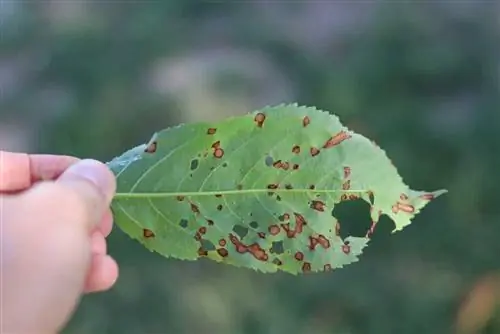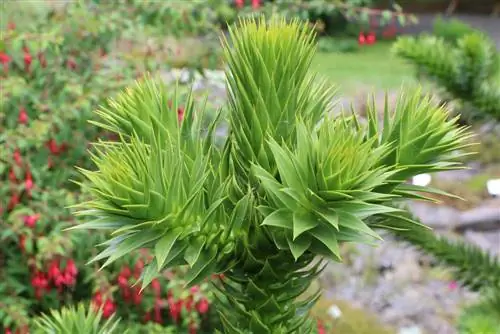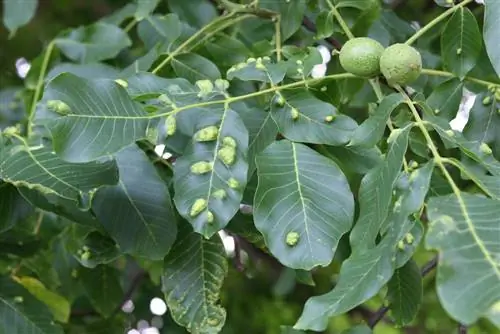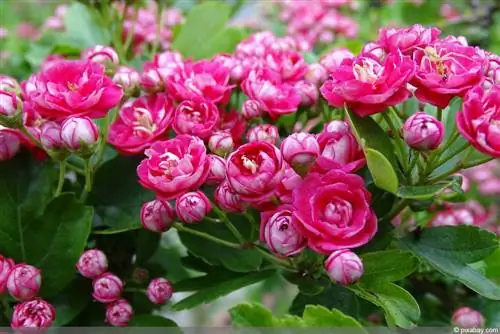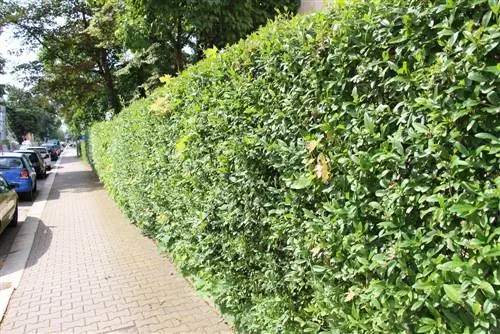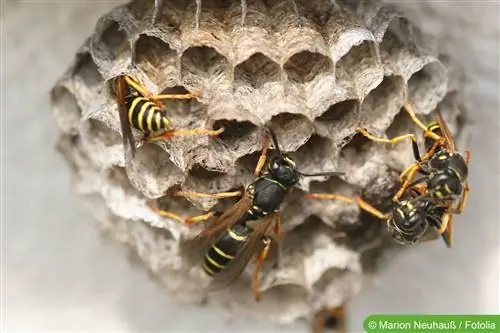- Author admin [email protected].
- Public 2023-12-17 03:39.
- Last modified 2025-01-24 12:45.
If a tree is not doing well, it can have various causes: from damage caused by frost to an infestation with animal pests. Tree diseases that are caused by infection with microorganisms are particularly important to take seriously. These diseases represent a serious danger to the tree. While care errors or pest infestations can usually be easily contained, an infection is very difficult to treat.
Diagnosis
Only an exact diagnosis can show what caused the tree's disease. It is important to find out whether it is a parasitic or non-parasitic tree disease. It must also be clarified whether there is an infectious disease or pest infestation that needs to be treated.
Non-parasitic damage
- Frost Damage
- Damage caused by drought
- Disorders in nutrient absorption
- excessive wetness
- Environmental influences such as exhaust fumes, road s alt and acid rain
Parasitic causes of damage
- Small mammals
- other pests such as insects and their larvae (fresh wood and dry wood insects)
- Mushrooms
- Viruses
- Bacteria
Non-parasitic causes of damage
The proportion of non-parasitic damage to trees is very high. Insects or microorganisms are not always to blame for the tree becoming diseased. The most common causes include the effects of specific location conditions, weather conditions or nutrient and water supplies. Each individual tree species has very specific requirements in terms of soil, lighting conditions and climatic requirements. The more these conditions deviate from the species-specific optimum at the home location, the more susceptible the tree becomes to diseases and pests. Examples of non-parasitic tree diseases include:
Omorikadying
On the Serbian spruce (Omorika spruce), whitening of needles occasionally occurs in late summer or autumn, later the needles turn brown and fall off. If the needle drop occurs over a long period of time, the entire tree can die. The shoot tips of the tree are particularly affected. The cause of this is a disturbed nutritional status.
Cause
This disease usually occurs in moderately acidic or heavily compacted loamy or clay soils that tend to become waterlogged. For this type of spruce, the supply of magnesium is particularly important. If the soil contains a lot of potassium, this leads to a reduction in magnesium absorption.
Measures
Omorika spruces must not be supplied with potassium-based fertilizers and/or lime. A complete mineral fertilizer, Epsom s alt and a special magnesium fertilizer are recommended in spring.
Parasitic diseases
If a tree is diseased, the first thing to do is to find out whether it is a real disease or an infestation with an insect pest. Microorganisms penetrate the tree's pathways primarily through wounds and can infect the entire tree through the pathways. The most common cause of illness is fungi, but there are also tree diseases that are caused by viruses or bacteria.
Fungal diseases
Tree diseases caused by fungi can mainly be de alt with preventively. Once the infection is visible, there is usually no pesticide available to kill the pathogen. If the infestation is not yet very advanced, the spread can be contained by generously cutting diseased parts of the plant down to the he althy wood. Fungal infections tend to occur in damp weather.
Wilt pathogen
In addition to a lack of water and waterlogging, fungal pathogens in particular can be the cause of the wilting of trees.
Gray horse
In spring, in damp, cold weather, the young shoots and flowers of various trees and shrubs can be attacked by gray mold fungus (Botrytis cinerea).
malicious image
The young shoots and flowers of deciduous and coniferous trees suddenly become limp and brown. Double flowers that dry poorly will rot. If the moisture persists over a longer period of time, a gray fuzz forms on the flowers.
Affected plants
almost all deciduous and coniferous trees
Measures
Immediately cut out affected plant parts generously. Avoid nitrogen-based fertilizers and ensure that the shoots are well ventilated.
Monilia Lace Drought
The fungus (Monilia laxa) penetrates the trees through the flowers and can cause entire branches to die in the event of rain or increased dew formation.
malicious image
During and after flowering, the flowers and leaves at the tips of the shoots turn brown and hang limply.
Affected trees
- Almond bush
- ornamental cherry
Measures
Cut all dead shoots back to he althy wood as early as possible. Treatments with fungicides for prevention are possible. Please note the current information from the Plant Protection Office!
Stem and root rot
Compacted soil and waterlogging promote an infestation with stem and root rot, which is caused by the fungus Phytophthora.
malicious image
Purple-colored, spongy rotten spots that smell of bitter almonds form in the lower trunk area. The leaves of infected trees turn pale green and curl up at the branch tips. The pathogen can cause the entire tree to die.
Affected trees
all types of trees
Measures
Cut out all rotten areas generously down to the he althy tissue. Relocate the tree (if possible) and provide a well-drained substrate. In extreme cases, dead plants must be removed as early as possible. No tree or shrub may be planted in the same location for several years.
Whorl fungus (Verticillium wilt)
The whorl fungus (Verticillium) penetrates the tree through the roots, spreads through the ducts and clogs them, thereby impairing water transport. The whorl fungus also secretes toxins that cause the leaves to wilt. A clear diagnosis is only possible through a laboratory.
malicious image
Individual branches suddenly wither and die. The disease is often only visible on one side. The symptoms are particularly pronounced during dry periods that occur in early summer.
Affected trees
- vinegar tree
- Fan Maple
- Tree of Gods
- Japanese maple species
- Chestnut
- Magnolia
- wig bush
- Trumpet tree
Measures
Avoid wet locations that are slow to warm up in spring. When infestation begins, cut all infected branches back to he althy wood.
Leaf spot pathogen
Very dense vegetation, poorly ventilated locations and years with frequent rain showers and high humidity promote these tree diseases. In order to prevent susceptibility, professional thinning is essential. Not all leaf spots are of parasitic origin; strong temperature fluctuations or nutrient problems are often to blame, or it is a case of sunburn.
Leaf Tan
In addition to the leaf miner, leaf browning, which is caused by the fungus Guignardia aesculi, is the most common pathogen on horse chestnuts. Plane trees occasionally suffer from leaf browning, which is caused by the pathogen Apiognomonia veneta. The tree disease develops primarily on the bark and progressively spreads to the leaves. The fungus overwinters in the bark and in autumn leaves.
malicious image
Local cell death occurs in the form of brown, sunken spots (leaf necrosis) on the foliage that can overcome the leaf veins. If necrosis is severe, the edge of the leaf curls upwards and the leaves fall off prematurely. The leaves of plane trees turn black from the leaf veins.
Affected trees
- Horse Chestnut
- Plane tree
Measures
Remove fallen leaves to prevent reinfection.
Scab fungi
In wet weather in spring, the spores of these fungi can overwinter on the dead leaves and infect the trees.
malicious image
Olive-brown to black colored spots on the leaves, fruits and flowers of various tree species. The shoot tips die off.
Affected trees
- Firethorn
- Crabapples
- different deciduous trees
Measures
Plant hardy varieties and clear leaves in the fall. A thinning cut ensures better ventilation in the crown.
Shotgun disease
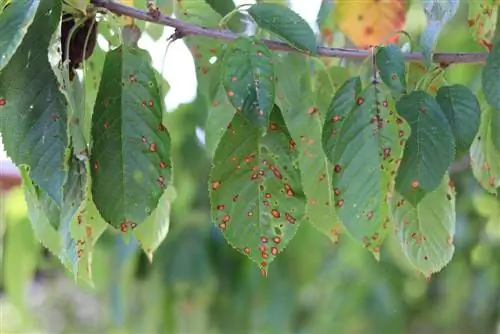
In addition to a fungal infection, there are many other causes of shotgun disease. The affected trees should therefore be examined in the laboratory.
malicious image
Red-brown spots form on the leaves, which later fall out of the leaf tissue, leaving holes that look as if they were caused by a shot from a shotgun.
Affected trees
- ornamental cherry
- ornamental plum
- Laurel Cherry
Measures
Optimal location and balanced water supply are very important. Mulch the trees and do not overspray the foliage with water in the evening so that the leaves are dry at night.
Juniper rust/pear grate
Rust infections on junipers have been occurring again and again recently, especially in regions close to cities. This is an infestation with the fungus Gymnosporangium fusum, which also occurs on pears (pear grate).
malicious image
In spring, cone-shaped, yellowish-brown structures up to two centimeters long grow on the branches. The branches of the juniper begin to twist and die.
Infested trees
- Juniper
- Pear
- Hawthorn
- Rowberry
- Apple tree
- Cotoneaster
Measures
If the trees mentioned above are cultivated in the garden, they must be planted at a minimum distance of 800 m. Since there are hardly any gardens of this size, cultivating them together is not recommended. In the early stages, it is possible to cut out affected branches. There is no antidote against the fungus.
White pine bubble rust
Infections with the fungus Cronartium ribicola occasionally occur in spring on five-needle pines such as the white pine.
malicious image
Pea-sized yellow bubbles grow out of the bark and release yellowish spore powder. The bark is cracked and there is heavy resin flow. The fungus also occurs on the black currant (currant columnar rust) and is able to change hosts. Infected trees usually die after a few years.
Infested trees
- White pine
- Swiss pine
- Girlspine
- brush pine
Measures
Remove infected trees from the garden immediately. Do not cultivate blackcurrants with these trees in the garden.
Powdery mildew
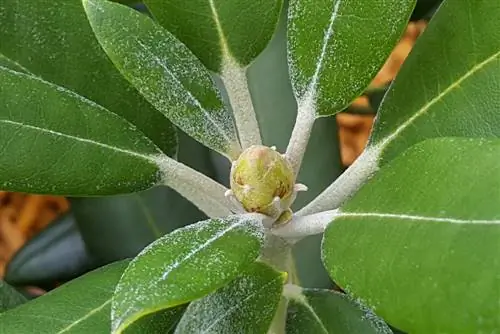
Powdery mildew (Erysiphales) is a fungus that can affect almost all types of plants. In contrast to all other types of fungi, powdery mildew is a so-called fair-weather fungus that occurs in warm, dry weather periods.
malicious image
Clearly visible white coatings on the top of the leaves, flowers and fruits. The fungus penetrates the leaf tissue and feeds there. Young shoots and leaves curl, curl or are misshapen. Brown or black fruiting bodies later form on the white coating.
Infested trees
almost all types of trees
Measures
The fungal network overwinters in the buds or on the shoots. These need to be cut out. The fungus cannot survive on dead leaves.
Wood destroying mushrooms
These fungi prefer to attack severely weakened trees or dead tissue.
Red pustule disease
The red pustular disease (Nectria cinnabarina) is most clearly visible in winter. The fungus breaks down dead wood and can cause the entire tree to die.
malicious image
Numerous vermilion-red, pinhead-sized pustules appear on bare branches or the trunk.
Infested trees
- aged hornbeam hedges
- trees damaged by frost in unfavorable locations
Measures
Cut out diseased plant parts and dispose of them in household waste. Endangered and infected trees must not be left too dry, which is why penetrating watering is necessary.
Bacterial pathogens
In addition to fungi, bacteria can also penetrate the tree through injuries and cause damage. There are a variety of bacterial pathogens that can infect deciduous and coniferous trees. The most common include:
Firebrand
Fire blight is a dangerous tree disease and the most important bacterial disease of pome fruit, caused by the bacterium Erwinia amylovora. It can spread like an epidemic. The bacteria block the plant immune system. Infections usually occur during flowering when warm, humid weather conditions prevail.
malicious image
When infected, leaves, flowers and fruits turn dark brown to black and look as if they have been burned. Shoot tips curve like hooks, the foliage dries up and shrinks. When the humidity is high, milky drops (bacterial slime) emerge.
Infested trees
- Apple
- Pear and rock pear
- Quince
- all hawthorn species
- Firethorn
- Pear
- Rowberry
- all types of medlar
- Quinces
Measures
It is currently not possible to combat it. In the case of fresh infections, cut affected shoots back to he althy wood, remove them from the property in a plastic bag and dispose of small quantities with the residual waste. Alternatively, burn larger quantities. Fire blight must be reported, so the plant protection authority must be informed.
Tip:
When cutting out diseased shoots, only use sterile tools that you disinfect after each cut (for example with alcohol). Otherwise you might also infect the he althy shoots!
Overview
Some tree species are particularly susceptible to certain diseases. If damage to the plant is visible, it does not always have to be a tree disease. In many cases, animal pests are at work. A detailed examination of the tree usually provides information as to whether it is a “real tree disease” or an infestation with insects.
Coniferous trees
- Yew (Taxus): wilt pathogen (pests: gall mites, mealybugs, scale insects, weevils)
- Spruce (Picea): wilt pathogen (pests: spider mites, aphids, leaf miners)
- Pine (Pinus): rust (pests: mealybugs, scale insects, sawflies, various butterflies)
- Tree of life (Thuja): no common tree diseases (pests: leaf miners and web moths)
- Juniper (Juniperus): rust (pests: spider mites, mealy bugs, scale insects, leaf miners)
Deciduous trees
- Maple (Acer): wilt pathogen, leaf spot pathogen, leaf brown, powdery mildew (pests: gall mites, cicadas, aphids, mealy bugs, scale insects, butterflies)
- Birch (Betula): no common diseases known (pests: aphids, leaf bugs, leaf miners and web moths)
- Beech (Fagus): leaf browning (pests: gall mites, aphids, mealybugs and scale insects, butterfly rings)
- Oak (Quercus): Powdery mildew (pests: spider mites, aphids, sawflies, butterfly caterpillars such as the oak processionary moth, leaf beetles)
- Firethorn (Pyracantha): scab (pests: sawflies)
- Hornbeam (Carpinus): rare in he althy plants (pests: spider mites, gall mites, aphids and butterflies)
- Chestnut (Aesculus): wilt pathogen, leaf browning, rust and powdery mildew (pests: leaf miners and spider moths, butterflies)
- Lind (Tilia): leaf browning (pests: spider mites, gall mites, aphids, mealybugs and scale insects)
- Plane tree (Platanus): leaf browning (pests: leaf miners and spider moths)
- Robinia (Robinia): rarely get sick (pests: gall mites, leaf miners and spider moths)
- Trumpet tree (Catalpa): wilt pathogen (pests: hardly known)
- Elm (Ulmus): wilt pathogen (pests: gall mites, aphids, mealy bugs, scale insects, leaf sucker fleas)
- Willow (Salix): leaf spot pathogen, rust, powdery mildew (pests: spider mites, gall mites, sawflies, butterflies, leaf beetles)
- Hawthorn/Hawthorn (Crataegus): leaf spot pathogen, rust (pests: spider mites, aphids, butterflies)
- Crabapple (Malus): scab, shot, powdery mildew (pests: aphids, mealybugs, mealybugs, butterflies, weevils)
- Ornamental cherry (Prunus): wilt pathogen, leaf spot pathogen, scab, shot (pests: aphids, sawfly, leaf miner and spider moth, butterflies)
Preventive measures
You can do a lot to prevent possible disease in the tree when you select the type of tree and the location. If possible, use resistant tree varieties and also pay attention to optimal site conditions. A balanced fertilization, which should not be heavy on nitrogen, increases the tree's resistance. Also ensure that wounds caused by storms or frost are reduced to a minimum as soon as possible. If you regularly remove dead branches from the tree and occasionally make thinning cuts so that the crown is well ventilated, you will prevent excessive moisture accumulation. A decisive factor in preventing infections and thus diseases of the tree.
Tip:
If you are not sure what disease the tree is suffering from, it is recommended to contact an expert. In an emergency, you may be able to prevent the disease from falling or spreading further.
Conclusion
Regular inspection of the trees in the garden is absolutely necessary in order to detect possible diseases at an early stage. This is the only way you can intervene when it is still possible - and often with very simple measures.

